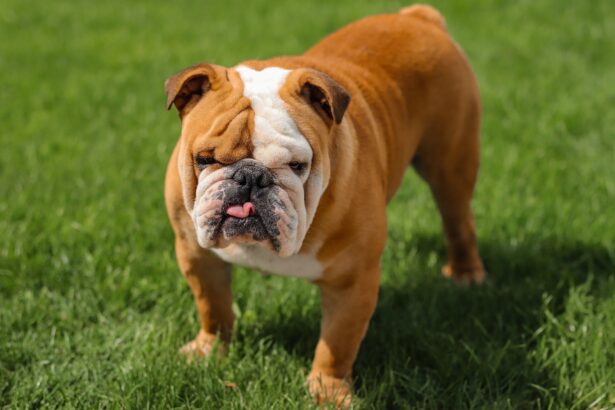As pet parents, we know that we’re meant to provide lots of things for our pets to keep them mentally stimulated and enriched, but is there such a thing as too much? How much is too much enrichment for an English bulldog – and what happens when overstimulation happens?
Thankfully, pet parents, we’re answering all of your enrichment for an English bulldog questions.
How much enrichment does an English bulldog need?
According to experts, enrichment for an English bulldog should make up around twenty percent (20%) of a bulldog’s day, which amounts to approximately two hours.
This sounds like a lot, but it’s easier than you’d think to incorporate enrichment activities into your bully’s life, and you’re probably already doing close to two hours per day already.
For example, feeding time with enrichment tools, such as puzzle feeders, takes up 10 to 30 minutes each time, twice or three times per day – which equals half an hour to an hour and a half per day.
Whenever you take your English bulldog out for a walk; that’s enrichment.
Letting them sniff? Also, enrichment.
Tearing apart a cardboard box (which bulldogs seem to love?) Yep, totally enrichment
Playing fetch or other toys with them? Yes, that’s enrichment, too.
When you add up all of the smaller play times, feeding times, walks, and other enrichment activities, it probably comes close to a couple of hours, right?
It’s also important to remember that bulldogs require different amounts of physical activity and mental enrichment or stimulation throughout the ages.
Puppy bulldogs
Bulldog puppies have a fair bit of energy – more so than their adult counterparts. This level of activity and need for mental stimulation isn’t constant, though; younger pups need shorter bursts, with lots of little naps.
Adult bulldogs
Adult bullies can have plenty of energy, despite what you might have read on the internet; but, once again, this level of need isn’t constant. The bursts are slightly longer, with shorter naps – but it’s still interspersed with naps and relaxation time.
It’s thought, by experts, that adult bulldogs need slightly more mental enrichment than physical exercise, so it’s important to make sure that yours has plenty to keep them occupied at home.
Elderly bulldogs
Elderly or senior bulldogs still require physical exercise and mental enrichment albeit a little less than their adult or puppy counterparts, and in shorter bursts.
Things like shorter and/or modified walks with playtime that is lower in intensity work well, alongside enrichment items that don’t require too much movement. Puzzle feeders, lick mats, snuffle mats, and even foraging for kibble (instead of popping it into a bowl) in the garden are also great activities to mentally stimulate the minds of wearier doggos.

How much enrichment is too much for an English bulldog?
Bulldogs are a stubborn breed, so there’s a high chance that they will let you know, in one temper-tantrum way or another, that they’re done with whatever activity you’re doing.
Forcing them to continue when they don’t want to, is a recipe for overstimulation… and, again, a temper tantrum – and bully temper tantrums are loud.
Battersea says:
“Overstimulation usually occurs when your dog is overwhelmed and can’t cope with certain triggers in their environment.”
You know your doggo better than anyone else, so you should have a good idea for when they’re getting tired or close to overstimulation and/or if they’ve had too much enrichment for English bulldogs.
As previously mentioned, around twenty percent of your dog’s day (or two hours, approximately) should be spent on various enrichment and mental stimulation activities. More than that could cause overstimulation.
How to tell if a bulldog is overstimulated
Overstimulation can look very different in different dogs, and not just for different breeds. Frank is and George was an English bulldog, and their behaviours and traits are quite different. George (may he RIP) would stomp off in a huff when he was overstimulated, but Frank tends to get zoomier, bark more, and even get a little snappy.
Puppy overstimulation can also look different from adult or senior bulldog overstimulation, too. This is why it’s so important to get to know your doggo, properly, becoming comfortable and properly accustomed to their behaviours. The more time you spend with them, the more you will spot the signs.
Bulldog overstimulation often looks like:
- Nipping or biting
- Chewing
- Digging
- Barking excessively
- Whining or crying
- Not being able to sit still
- Excessive licking, scratching, or grooming
- Pacing
- Excessive or chronic panting
- Extra zoomies/hyperactivity
- Jumping up at people, furniture, etc.
- Tense, stiff posture
- Lead tugging or pulling
Why is overstimulation in bulldogs bad?
Overstimulation in bulldogs is similar to sensory overload or overwhelm in humans – so imagine how you feel, when you’re stressed to the max… then imagine how confusing and uncomfortable it must be for your four-legged friend.
Overstimulation in dogs leads to biting and other aggressive behaviours, which could prove dangerous – and in some cases, even deadly – for humans and other animals.
Overwhelm and overstimulation in the long-term can have serious side effects for your doggo’s health, causing long-term and chronic anxiety, decreased ability to cope with the regular stresses of day-to-day life, and behavioural difficulties and/or aggressiveness that could prove difficult to train out.

Conclusion: How much is too much enrichment for an English bulldog?
Roughly two hours of your dog’s day should be spent on enrichment, whether that’s food, toy, walk, or other forms of mental and/or physical stimulation. Some dogs will prefer a little more; others, a little less.
Get to know your doggo. Figure out what’s “normal” for them, so you can tell, as early as possible, when something isn’t.
As always, if you’re in any doubt as to your bulldog’s care or health, seek advice from a vet – that’s what they’re there for, after all!



